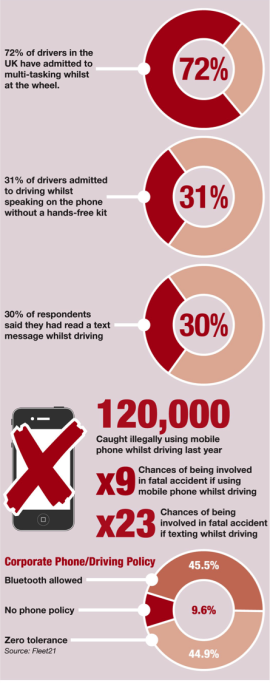Your Mobile Phone: Essential Business Tool or Deadly Hazard?
The possibilites of the mobile office prove a tempting but dangerous distraction for many drivers. How can this risk be managed effectively?
Mobile phone technology has advanced so far in recent years that we now have the whole world at our finger tips accessed via our phone. A car is an extended office, workers use this time to make and receive calls and people have begun to get used to the idea of being accessible 24/7. We all embraced this development and it has certainly increased productivity in many areas, however it is now shown to be putting workers at risk. No matter what your profession, these days a mobile phone will be considered a tool of the trade.

With the advance of technology workers are now able to use their phones for so many different tasks, not just for phoning into the office. Smart phones now enable us to send and receive emails, so clients can always get in touch, texting too. Those running social media marketing campaigns are no longer confined to the office as it can all be done on the move. All appointment scheduling, job completion and job sign off can be done from a hand held phone. There is no need to return to the offices. Many workers now use their phones for photography - for example when collecting rental cars, they can record damage and send it straight through to the office.
Now workers can use their phones for mileage validation, record time spent at premises, manage their expenses and in turn validate their efficiency. So realistically, workers can now manage their entire working lives from their vehicle.
However, whilst the user is not physically distracted by having to handle and hold the phone their mind is just as distracted, this is known as "Cognitive Distraction". It is recognised that the mobile phone or tablet is a normal and essential part of everyday business use, yet it still presents the biggest danger to employees during the course of their working day
Distracted driving is usually divided into 3 components:
Visual: Distractions that cause drivers to take their eyes off the road.
Manual: Distractions that cause drivers to take their hands off the wheel.
Cognitive: Distractions that cause drivers to divert their attention from the road.
The law banning the use of hand help mobile phones whilst driving came out in 2003 (although the use of Bluetooth is permitted), there is now a conflict between the desire to increase efficiency and that of protecting employees and other road users from the likelihood of a collision due to driver distraction. Unfortunatley, the temptations are too great and it is clear that employees are not adhering to the policy laid out by their companies or the law.
Interested? Want to read more?
Continue reading about this important subject by downloading the rest of this article as published in Fleet Safety Expert Issue 4.



